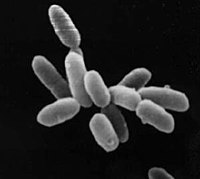Euryarchaeota
Appearance
| Euryarchaeota | |
|---|---|

| |
| Halobacterium sp. strain NRC-1, each cell about 5 µm in length. | |
| Scientific classification | |
| Domain: | |
| Kingdom: | Euryarchaeota
|
| Phylum: | Euryarchaeota Woese, Kandler & Wheelis, 1990
|
| Classes | |
| Synonyms | |
| |
In taxonomy, the Euryarchaeota (Greek for "broad old quality") are a phylum of the Archaea.[1]
The Euryarchaeota include the methanogens, which produce methane and are often found in intestines, the halobacteria, which survive extreme concentrations of salt, and some extremely thermophilic aerobes and anaerobes. They are separated from the other archaeans based mainly on rRNA sequences.
See also
References
- ^ See the NCBI webpage on Euryarchaeota. Data extracted from the "NCBI taxonomy resources". National Center for Biotechnology Information. Retrieved 2007-03-19.
Further reading
Scientific journals
- Cavalier-Smith, T (2002). "The neomuran origin of archaebacteria, the negibacterial root of the universal tree and bacterial megaclassification". Int. J. Syst. Evol. Microbiol. 52: 7–76. PMID 11837318.
- Stackebrandt, E (2002). "Report of the ad hoc committee for the re-evaluation of the species definition in bacteriology". Int. J. Syst. Evol. Microbiol. 52: 1043–1047. doi:10.1099/ijs.0.02360-0. PMID 12054223.
{{cite journal}}: Unknown parameter|coauthors=ignored (|author=suggested) (help)
- Christensen, H (2001). "Is characterization of a single isolate sufficient for valid publication of a new genus or species? Proposal to modify recommendation 30b of the Bacteriological Code (1990 Revision)". Int. J. Syst. Evol. Microbiol. 51: 2221–2225. PMID 11760965.
{{cite journal}}: Unknown parameter|coauthors=ignored (|author=suggested) (help)
- Gurtler, V (2001). "Genomic approaches to typing, taxonomy and evolution of bacterial isolates". Int. J. Syst. Evol. Microbiol. 51: 3–16. PMID 11211268.
{{cite journal}}: Unknown parameter|coauthors=ignored (|author=suggested) (help)
- Dalevi, D (2001). "A multiple-outgroup approach to resolving division-level phylogenetic relationships using 16S rDNA data". Int. J. Syst. Evol. Microbiol. 51: 385–391. PMID 11321083.
{{cite journal}}: Unknown parameter|coauthors=ignored (|author=suggested) (help)
- Keswani, J (2001). "Relationship of 16S rRNA sequence similarity to DNA hybridization in prokaryotes". Int. J. Syst. Evol. Microbiol. 51: 667–678. PMID 11321113.
{{cite journal}}: Unknown parameter|coauthors=ignored (|author=suggested) (help)
- Young, JM (2001). "Implications of alternative classifications and horizontal gene transfer for bacterial taxonomy". Int. J. Syst. Evol. Microbiol. 51: 945–953. PMID 11411719.
- Christensen, H (2000). "DNA-DNA hybridization determined in micro-wells using covalent attachment of DNA". Int. J. Syst. Evol. Microbiol. 50: 1095–1102. PMID 10843050.
{{cite journal}}: Unknown parameter|coauthors=ignored (|author=suggested) (help)
- Xu, HX (2000). "A rapid method for determining the G+C content of bacterial chromosomes by monitoring fluorescence intensity during DNA denaturation in a capillary tube". Int. J. Syst.Evol. Microbiol. 50: 1463–1469. PMID 10939651.
{{cite journal}}: Unknown parameter|coauthors=ignored (|author=suggested) (help)
- Young, JM (2000). "Suggestions for avoiding on-going confusion from the Bacteriological Code". Int. J. Syst. Evol. Microbiol. 50: 1687–1689. PMID 10939677.
- Hansmann, S (2000). "Phylogeny of 33 ribosomal and six other proteins encoded in an ancient gene cluster that is conserved across prokaryotic genomes: influence of excluding poorly alignable sites from analysis". Int. J. Syst. Evol. Microbiol. 50: 1655–1663. PMID 10939673.
{{cite journal}}: Unknown parameter|coauthors=ignored (|author=suggested) (help)
- Tindall, BJ (1999). "Proposal to change the Rule governing the designation of type strains deposited under culture collection numbers allocated for patent purposes". Int. J. Syst. Bacteriol. 49: 1317–1319. PMID 10490293.
- Tindall, BJ (1999). "Proposal to change Rule 18a, Rule 18f and Rule 30 to limit the retroactive consequences of changes accepted by the ICSB". Int. J. Syst. Bacteriol. 49: 1321–1322. PMID 10425797.
- Tindall, BJ (1999). "Misunderstanding the Bacteriological Code". Int. J. Syst. Bacteriol. 49: 1313–1316. PMID 10425796.
- Tindall, BJ (1999). "Proposals to update and make changes to the Bacteriological Code". Int. J. Syst. Bacteriol. 49: 1309–1312. PMID 10425795.
- Palys, T (1997). "Discovery and classification of ecological diversity in the bacterial world: the role of DNA sequence data". Int. J. Syst. Bacteriol. 47: 1145–1156. PMID 9336922.
{{cite journal}}: Unknown parameter|coauthors=ignored (|author=suggested) (help)
- Euzeby, JP (1997). "List of Bacterial Names with Standing in Nomenclature: a folder available on the Internet". Int. J. Syst. Bacteriol. 47: 590–592. PMID 9103655.
- Clayton, RA (1995). "Intraspecific variation in small-subunit rRNA sequences in GenBank: why single sequences may not adequately represent prokaryotic taxa". Int. J. Syst. Bacteriol. 45: 595–599. PMID 8590690.
{{cite journal}}: Unknown parameter|coauthors=ignored (|author=suggested) (help)
- Murray, RG (1994). "Taxonomic notes: a proposal for recording the properties of putative taxa of procaryotes". Int. J. Syst. Bacteriol. 44: 174–176. PMID 8123559.
{{cite journal}}: Unknown parameter|coauthors=ignored (|author=suggested) (help)
- Winker, S (1991). "A definition of the domains Archaea, Bacteria and Eucarya in terms of small subunit ribosomal RNA characteristics". Syst. Appl. Microbiol. 14: 305–310. PMID 11540071.
{{cite journal}}: Unknown parameter|coauthors=ignored (|author=suggested) (help)
- Woese, CR (1990). "Towards a natural system of organisms: proposal for the domains Archaea, Bacteria, and Eucarya". Proc. Natl. Acad. Sci. USA. 87: 4576–4579. doi:10.1073/pnas.87.12.4576. PMID 2112744.
{{cite journal}}: Unknown parameter|coauthors=ignored (|author=suggested) (help)
- Achenbach-Richter, L (1988). "The ribosomal gene spacer region in archaebacteria". Syst. Appl. Microbiol. 10: 211–214. PMID 11542149.
{{cite journal}}: Unknown parameter|coauthors=ignored (|author=suggested) (help)
- McGill, TJ (1986). "Characteristic archaebacterial 16S rRNA oligonucleotides". Syst. Appl. Microbiol. 7: 194–197. PMID 11542064.
{{cite journal}}: Unknown parameter|coauthors=ignored (|author=suggested) (help)
- Woese, CR (1984). "The phylogenetic relationships of three sulfur dependent archaebacteria". Syst. Appl. Microbiol. 5: 97–105. PMID 11541975.
{{cite journal}}: Unknown parameter|coauthors=ignored (|author=suggested) (help)
- Woese, CR (1977). "Phylogenetic structure of the prokaryotic domain: the primary kingdoms". Proc. Natl. Acad. Sci. USA. 74: 5088–5090. doi:10.1073/pnas.74.11.5088. PMID 270744.
{{cite journal}}: Unknown parameter|coauthors=ignored (|author=suggested) (help)
Scientific books
- Garrity GM, Holt JG (2001). "Phylum AII. Euryarchaeota phy. nov.". In DR Boone and RW Castenholz, eds. (ed.). Bergey's Manual of Systematic Bacteriology Volume 1: The Archaea and the deeply branching and phototrophic Bacteria (2nd ed. ed.). New York: Springer Verlag. pp. p. 169. ISBN 978-0387987712.
{{cite book}}:|edition=has extra text (help);|editor=has generic name (help);|pages=has extra text (help)
